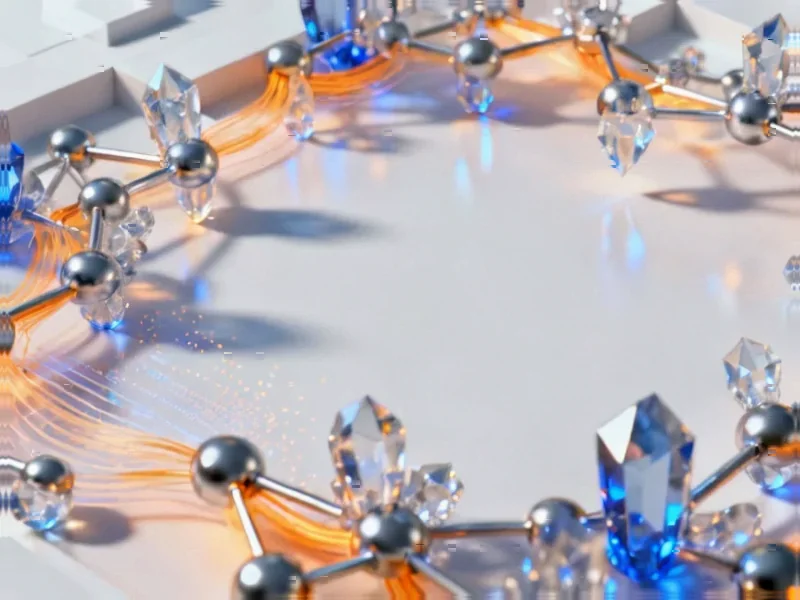According to Nature, researchers have developed a porous membrane electrolyte system that achieves superionic conduction through in situ structural transformation in electrochemical cells. The optimized TiO-6% polystyrene template structure demonstrated record power density of 1239 mW cm² at 550°C, more than doubling the performance of conventional TiO-based cells. This breakthrough approach creates dynamic heterointerfaces that significantly reduce activation energy for ion transport while maintaining structural stability across operating temperatures.
Table of Contents
Understanding the Science Behind Superionic Conduction
The fundamental challenge in electrochemical energy systems has always been balancing ionic conductivity with structural stability. Traditional solid electrolytes face the “conductivity-stability tradeoff” – materials that conduct ions well often lack mechanical robustness, while stable structures typically impede ion movement. What makes this research particularly innovative is the use of optimized surface area through controlled porosity to create pathways for both ion transport and structural transformation.
The concept of heterointerfaces isn’t new – researchers have long known that boundaries between different materials can create unique electronic and ionic properties. However, previous approaches typically involved pre-fabricated heterostructures that were static and often degraded during operation. The in situ transformation approach represents a paradigm shift, creating dynamic interfaces that self-optimize during operation. As the heterojunction forms naturally between LiTiO and LiCO, it establishes precisely the right electronic structure for efficient ion hopping while maintaining mechanical integrity.
Critical Analysis of Technical Challenges
While the performance numbers are impressive, several practical challenges remain unaddressed in the current research. The 550°C operating temperature represents a significant barrier to commercial adoption – most consumer and even industrial applications require operation below 300°C. The thermal management overhead alone could negate the efficiency gains in many real-world scenarios.
The characterization methods, including Raman spectroscopy and scanning electron microscopy, confirm the structural transformation, but they don’t address long-term stability concerns. Dynamic interfaces that form during operation could continue evolving, potentially leading to performance degradation over hundreds or thousands of cycles. The research shows excellent short-term performance, but the absence of extended cycling data leaves questions about commercial viability.
Another concern is the scalability of the polystyrene template approach. Creating uniform 20nm particles with precisely controlled 6% porosity across large surface areas represents a manufacturing challenge that current industrial processes may struggle to achieve consistently. Minor variations in pore distribution could lead to significant performance drops in commercial-scale cells.
Industry Implications and Market Potential
This technology could have the most immediate impact in stationary energy storage and high-temperature fuel cells, where thermal management is more feasible than in mobile applications. The demonstrated power density of 1239 mW cm² puts it in competition with the best solid oxide fuel cells currently available, but with potentially better longevity due to the self-healing nature of the in situ interfaces.
The manufacturing approach using template combustion could disrupt current solid electrolyte production methods. Most commercial solid electrolytes require expensive vacuum deposition or high-pressure sintering processes. If the polystyrene template method can be scaled, it could significantly reduce production costs while improving performance – a rare combination in materials science.
Beyond energy storage, the principles demonstrated here could influence other fields requiring controlled ion transport. Membrane separation technologies, chemical sensors, and even neuromorphic computing devices could benefit from the fundamental understanding of how dynamic heterointerfaces facilitate ion movement while blocking electronic conduction.
Realistic Outlook and Development Timeline
The path from laboratory breakthrough to commercial product will likely take 5-8 years, assuming the technical challenges can be overcome. The first applications will probably emerge in specialized industrial and military contexts where performance outweighs cost considerations. Widespread adoption in consumer electronics or electric vehicles remains further out due to the temperature constraints.
The most promising near-term development would be adapting this approach to lower-temperature systems. If researchers can achieve similar in situ transformations at temperatures below 300°C, the technology could rapidly displace current solid-state battery electrolytes. The demonstrated activation energy reduction from 1.05 eV to 0.47 eV suggests this might be possible with further material optimization.
Competitive technologies like sulfide-based solid electrolytes and polymer-ceramic composites are advancing rapidly, so the window for commercialization may be narrow. However, the unique combination of high conductivity, structural stability, and potentially lower manufacturing costs gives this approach a compelling value proposition if the technical hurdles can be cleared.



